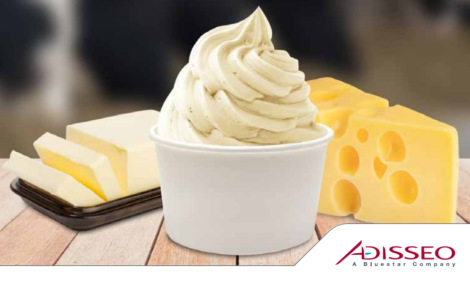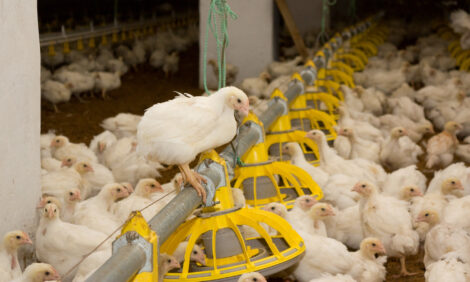



Genotype x Environment Interactions in Poultry
When the ranking of two genetic groups change under different environments, we call it Genotype Environment interaction, writes Dr T. Kotaiah from Indbro Research & Breeding Farms Private Limited.The hybrid crosses of the Pure line birds bred under moderate & controlled climates and imported in to India as grand parents & multiplied further are available in India. These birds are accepted world over. The breeding companies also provide technical services. They advise the best feed formula and controlled climate under which excellent results are achieved.
India has pure line breeding programs and they are successful in developing hybrid birds that suit their climate and the market. The breeding work is under taken in open sided houses and with ordinary feed. 80 per cent of layer stocks and 60 per cent broiler stocks purchased by farmers in India are from Indian bred birds.
The breeding work under practical conditions, where the birds have to perform is found to have resulted in building up of "Adaptability" which is described in terms of 1. Temperature tolerance and 2. Acceptance of lower quality feed.
A trial was conducted on the commercial hybrids of two imported and two Indian bred birds under two feed regimes. One, the modern well formulated quality feed fed under phase feeding (HE) and the second, a two stage starter and growing mash feeding system which is common in India(LE). To summarize the data, the average of two breeds of same origin are averaged and presented. The variation among the two similar groups is found to be not much.
Types of feed
| Nutrient | High Energy | Low Energy | ||||
|---|---|---|---|---|---|---|
| Pre starter | Starter | Grower | Finisher | Starter | Starter | |
| CP (%) | 23.5 | 22.0 | 21.0 | 19.5 | 21.5 | 20.0 |
| ME (k cal) | 3000 | 3050 | 3125 | 3200 | 2860 | 2940 |
| Fiber (%) | <4.0 | <4.0 | <4.0 | <4.0 | <4.5 | 4.0 |
| Fat (%) | 4.0 | 4.5 | 5.0 | 5.5 | 3.5 | 4.0 |
| Vitamins & trace Min | 125% |
100% |
||||
| Feed Qty (g) | 200 | 500 | 1000 | 2000 | 1500 | 2000 |
| Price/Kg (Rs) | 19.2 | 19.2 | 20.00 | 20.00 | 17.2 | 16.5 |
| Growth promoters | Added |
None |
||||
Cost of Production |
||||
| Type of breed | High energy | Low energy | High energy | Low energy |
|---|---|---|---|---|
| Breed | AA (moderate climate) | BB (Hot climate) | AA (Moderate climate) | BB (Hot climate) |
| Body weight | 2.03 | 2.10 | 1.41 | 1.82 |
| FCR | 2.05 | 1.93 | 2.39 | 2.22 |
| Quantity starter | 1.0Kg | 1.0Kg | 1.0Kg | 1.0Kg |
| Quantity finished | 3.16Kg | 3.07Kg | 2.38Kg | 3.04Kg |
| Feed cost/Bird | 82.40 | 80.6 | 56.47 | 67.36 |
| Feed cost /Kg wt. | 41.20 | 40.3 | 40.1 | 37.0 |
| Cost difference | Rs(-0.9)/Kg | Rs (-2.9)/Kg | ||
The cost of production of BB is lower by Rs2.9/Kg under average feed in hot climate compared to AA.
There are some months where the prices of chicken are bound to be low. The broiler grower is “sure to loose”. An integrator cannot stop placing the chicks in certain months. With BB, he can opt for cheaper feed and reduce the cost of production.
The factual weekly performance is given below. The weekly weights are sample weights. The 43rd day weights are taken on 100% of the available birds. The sex of the bird was recorded while weighing the birds. The variation was calculated for each sex separately.
Performance of Broilers |
||||
| Type of feed | High energy | High energy | Low energy | Low energy |
|---|---|---|---|---|
| Breed | AA (moderate climate) | BB (Hot climate) | AA (moderate climate) | BB (Hot climate) |
| No of chicks reared | 500 | 555 | 602 | 549 |
| No of males (end) | 226 | 245 | 281 | 275 |
| No of females (end) | 250 | 285 | 299 | 259 |
| 1 Day weight | 43 | 45 | 43 | 45 |
| 8th day weights | 168 | 177 | 122 | 142 |
| 16th day weights | 413 | 457 | 309 | 374 |
| 22nd day weights | 707 | 818 | 579 | 698 |
| 29th day weights | 1181 | 1255 | 846 | 1058 |
| 36th day weights | 1608 | 1686 | 1083 | 1257 |
| 43rd day weights | 2026 | 2104 | 1411 | 1820 |
| FCR 42 days | 2.05 | 1.93 | 2.39 | 2.22 |
| Coefficient of Variation % males | 13.48 | 13.37 | 20.29 | 12.35 |
| Coefficient of variation females% | 12.69 | 13.13 | 24.73 | 11.54 |
| Mortality 6 wks % | 4.50 | 4.4 | 3.6 | 2.7 |
Breed comparison - weight gain
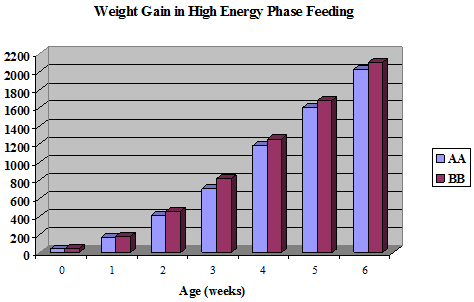
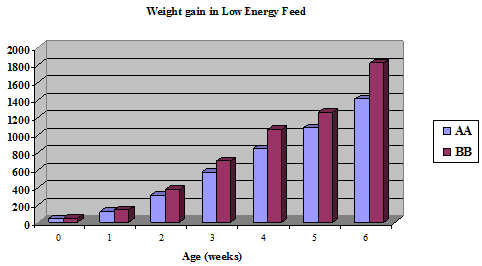
To ascertain the genetic effect of the adaptability, AA, AB and BB were reproduced on the same day by mating AA females to AA males, AA females to BB males and BB females to BB males. All three genotypes were produced on the same day, identified by de-toeing marks and were reared in the same pen in hot climate with low energy feed. BB had higher weight gain followed by AB which was almost in between leaving AA far behind in weight gain. AS shown in the earlier earlier experiment, the flock variation also followed the same pattern. The data is graphically presented below.
The flock mortality in hot months was heaviest in AA and lowest in BB, AB being in between.
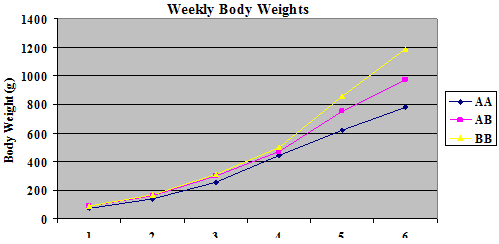
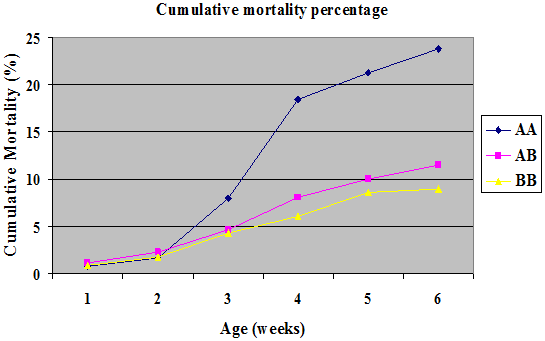
Climate
Two breeds AA (Bred under moderate climate) and BB ( Bred under hot climates) were compared under open house conditions in India.
During hot summer months (the day temperatures peaked 40°C+) and in monsoon season when the day temperatures did not exeed 34°C.
The quality of feed offered to both the breeds in both the climates is similar, like the HE feed described above. The table below shows that the birds bred under hot climates (BB) maintained the feed consumption & growth and maintained the daily growth & mortality. The birds bred under moderate climates(AA) did well in cooler climates but failed miserably when the day temperatures exceeded 40°C.
| Character | 40C+(hot) | 40C+(Hot) | 34C(moderate) | 34C(moderate) |
|---|---|---|---|---|
| Breed | Moderate climate AA | Hot climate BB | Moderate climate AA | Hot climate BB |
| 40 days weight | 1622 | 1930 | 2297 | 1944 |
| FCR | 2.059 | 1.639 | 1.933 | 1.914 |
| Daily gain | 40.6 | 48.3 | 57.4 | 48.6 |
| Feed/bird | 3339 | 3164 | 4440 | 3720 |
| Depletion | 23.29 | 8.01 | 5.8 | 6.51 |
The options before the broiler producer is to rear the broilers under climate controlled houses in hot climates. The climate controlled houses are expensive to build & the depreciation is high. They need consistent power supply and the power is expensive in many countries. The running cost is high.
Many of the Asian countries sell birds in live markets. The birds that are taken out of controlled houses suffer heavy stress, weight loss and mortality when brought out of the climate controlled houses and held in to the open climate.
A calculated comparison of both housing systems is given below.
| Details | Open House | E.C House |
|---|---|---|
| Width (Feet) | 40 | 40 |
| Length (Feet) | 300 | 300 |
| Area (SFT) | 12000 | 12000 |
| Cost of house (@ Rs 160/bird)/500/bird. | 19,20,000 | 1,20,00,000 |
| Cost of equipment (Rs) | 2,00,000 | |
| Total (Rs) | 21,20,000 | 1,20,00,000 |
| Number of Birds (Rs) | 12,000 | 24,000 |
| Cost/Bird (Rs) | 175 | 500 |
| Running cost (Rs/bird) | 1.0 | 5.0 |
| Depreciation/year @ 10% | 2,10,000 | 12,00,000 |
| Transit stress | Nil | High |
The producer needs huge capital to build these houses and run them. The performance of the broilers should be much higher to off set the extra running cost and the birds should be accepted in the live bird market.
Summary & Conclusions
Broilers bred under moderate climates since many years have a great genetic potential for growth and meat yield. They require moderate climates and good feed to express their genetic potential. Many developing countries do not have access to the best of the feed or it is expensive. Maize is getting costlier every year and is likely to continue due to it’s diversion to Ethonol production. Besides, there are "Sure to loose" situations in integrated broiler production, where low investment on cheaper feed will be a better game plan.
Environment controlled broiler houses also give excellent results through out the year with centralized control and less manpower.
But Environment controlled houses (E.C) are 1. Expensive to build, 2.Depreciation is high. 3.Energy costs is high & Power supply must be consistent and 4.Live markets do not accept EC reared broilers.
Breeding birds under hot climates & lower quality feed can be an alternative.
Birds bred under moderate climates (AA) and birds bred under hot climates & lower quality feed (BB) are compared under two types of feed. Cost of Kg broiler chicken is cheaper with BB.
A breeding experiment involving three genotypes AA,AB and BB suggests that there seems to be a genetic basis making BB birds more acceptable under Hot climates and low quality feed situations.
The cost effectiveness of EC houses discussed.







